FiiO KA17
Review of the Fiio KA17 DAC and Headphone Amplifier
FiiO’s latest flagship model of USB-C dongle, encompasses an array of innovative features providing the very small and portable dongle with the power and capabilities of a desktop unit. The KA17 has been the perfect usb-c dongle for me for the past few weeks. I have been commuting by train each day to work in a ‘hot desk’ environment where I couldn’t use my normal desktop headphone amplifier, but I never missed that desktop amplifier even when I decided to bring my harder to drive Hifiman planar headphones.
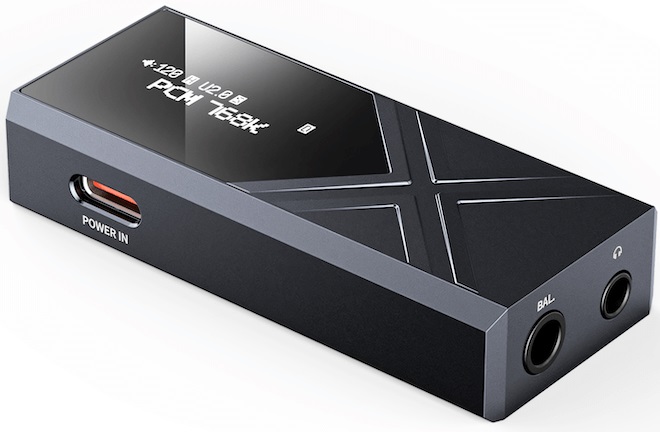
The FiiO KA17 has that perfect middle ground where it’s powerful enough where you won’t miss a desktop headphone amplifier but small enough to stick in my pocket.
I hope in this review to give you a feel if the KA17 might also be for you.
Note: I would like to thank FiiO for sending me KA17 for the purposes of this review - you check out more details about the KA17 on the FiiO website here for more information. The retail price of the KA17 is $149.99
Introduction
The FiiO KA17 sets a new benchmark for what can be achieved in the small footprint DAC and headphone amplifier category, combining exceptional audio quality with advanced features.
What is in the box
The KA17 comes in a nice premium box:
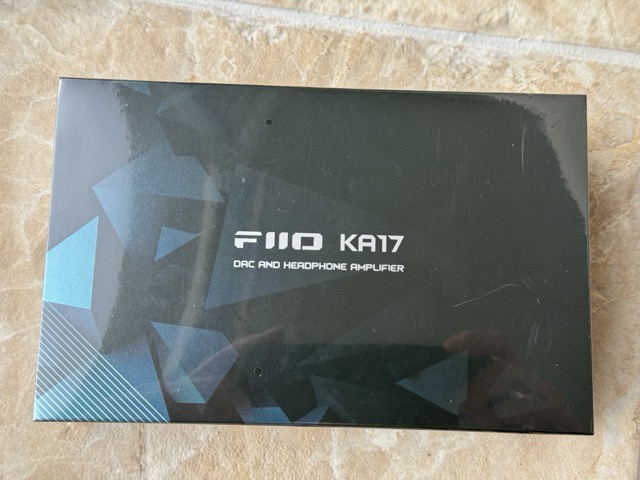
Once opened here is what we get in the box:
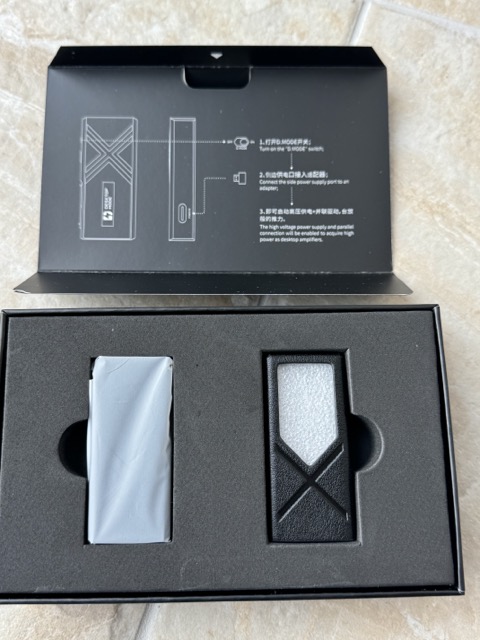
Once you remove the top layer you have an usb-c cable and adapter on the bottom layer:
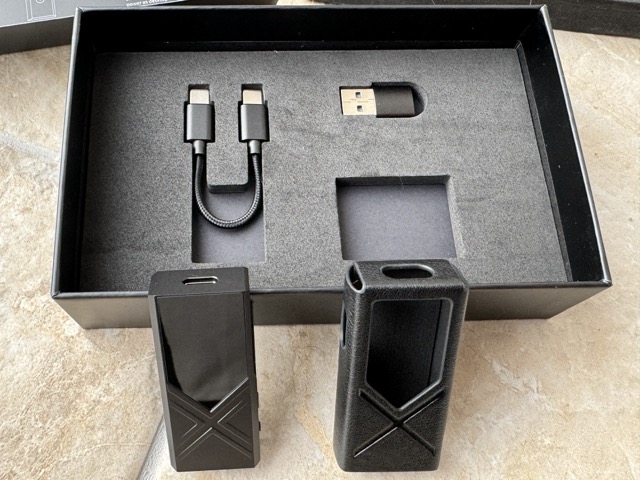
Once the KA17 is put into its protective carry case it’s a nice looking device:
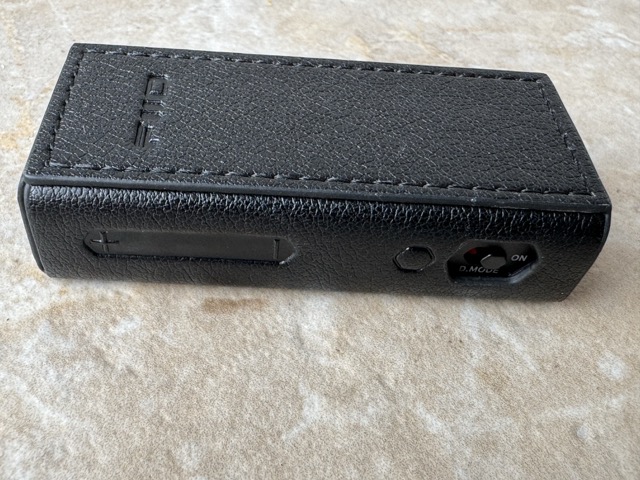
Note: Each color variant of the KA17 comes with a matching leatherette case.
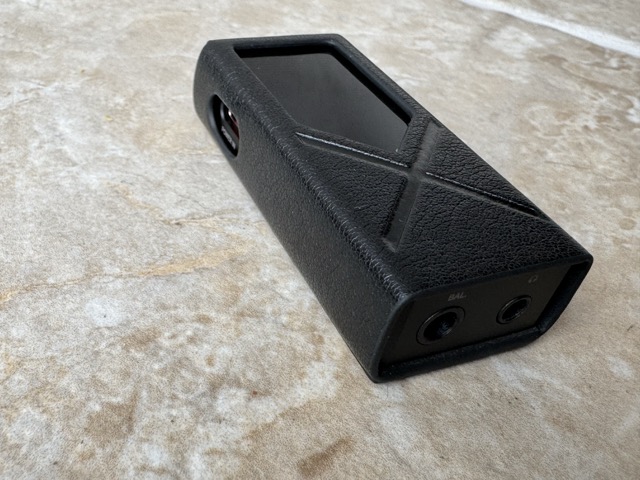
Build Quality
Here is a short video showing the build quality of the KA17 from all angles:
FiiO has paid close attention to the user experience with the KA17 with the dot matrix display and a sensible button layout to quickly cycle through the menu options on the device.
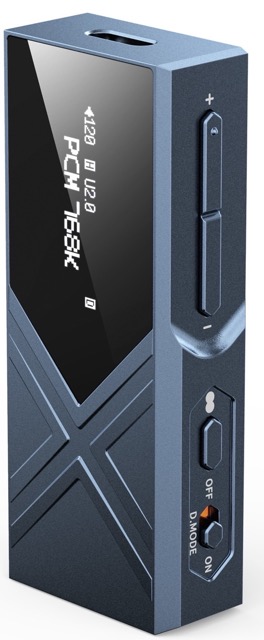
While the screen is mostly bright and easy to read, I did find when using it in bright sunshine it was a little hard to read.
The KA17 is designed with a robust aluminum alloy body, ensuring durability and effective heat dissipation, complemented by a compact and sleek form factor that does not compromise on power or functionality. I did found the KA17 got slightly warm in usage but it never ‘overheated’ during my usage.
Features
The KA17 is flagship device and FiiO has implemented some great features, let have an in-depth look at just a few of the standout features:
Independent Power Supply Port and Desktop Mode
Te KA17 “Desktop Mode” is activated when connected to a power adapter or sufficient USB power, I actually found it worked well even with my iPhone 15 Pro Max usb-c connection. But when using the KA17 at my ‘hotdesk’ desk I did plug it into a separate dedicated usb-c cable connected directly to the wall to save the battery in my phone while still utilise the desktop mode.
Once you enable this mode via the switch on the device, you immediately hear the difference, it is like switching from a portable dongle (like the excellent KA11) to a proper desktop amplifiers with the DAC, and THX amplifier capabilities getting an excellent boost in quality.
In Desktop Mode, the KA17’s balanced output can reach up to 650mW + 650mW, see the full power output specifications later the review.
Internal audio architecture
The KA17 employs the ESS ES9069Q, a 2-channel flagship DAC based on the fourth-generation Hyperstream technology, balancing high power and low distortion with excellent clarity.
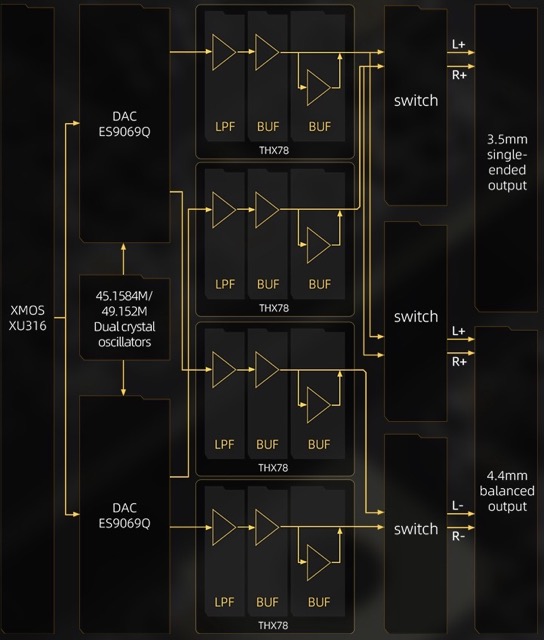
The dual DACs and four-channel fully differential audio amplification ensure excellent sound dynamics and separation.
The THX AAA 78+ Amplifier stage is also superb feature for such a small device, this previously featured in FiiO’s M11+Plus DAP.
The KA17 features a XMOS 16-core XU316 controller, offering low latency and high digital audio performance.
Here is a list of output formats available under UAC2.0 mode on my Windows 11 Laptop:
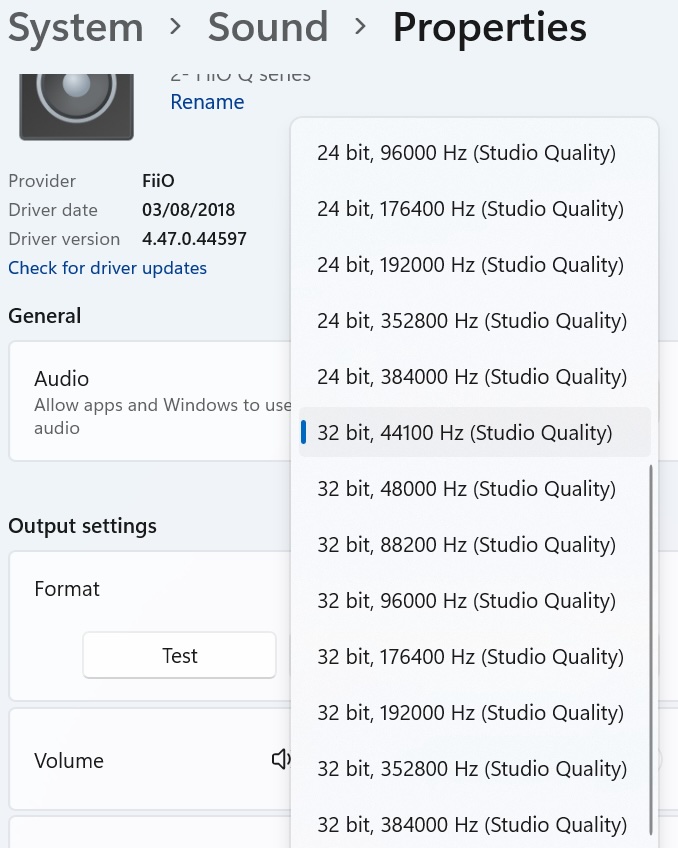
Specialized 10-band Parametric EQ
The KA17 boasts a 10-band parametric EQ, allowing users to adjust gain, frequency bands, bandwidth, and Q values, these PEQ profiles can be switched on the device using the built-in display but using the FiiO control application really allows you to customise the profiles.
EQ Profile switching via OLED display
The 0.91-inch display, a rarity in USB dongles, intuitively indicates different functions, complemented by physical buttons for customization. Users can adjust screen orientation, filters, and the display sleep timer, enhancing the device’s usability.
A fantastic feature of the KA17 (which it shares with some other FiiO devices like the BTR15) is the ability to switch EQ/Custom PEQ Profiles via the OLED screen built into the device:
As you can see the display allows lots of on-the-go configuration without needing to launch the FiiO Control application which for iPhone users is a fantastic as the IOS FiiO Control app cannot control the features due to Apple limitations.
FiiO Control Application
The PEQ graphical interface can be configured within the FiiO control Android application (unfortunately no IOS support
due to Apple current restrictions), each custom EQ starts with a flat configuration:
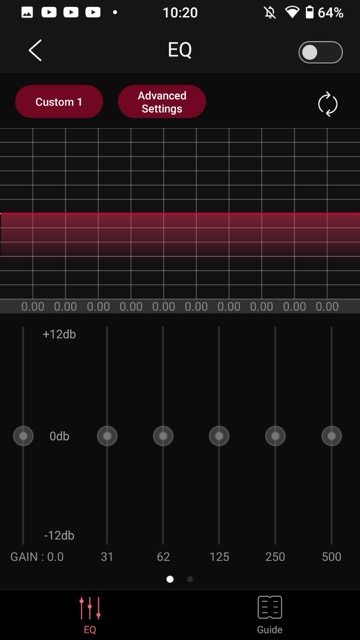
Using either the sliders to configure the EQ filters or by clicking the ‘Advanced settings’ to enter the PEQ values
manually you end up with a nice graphical view of the PEQ setup:
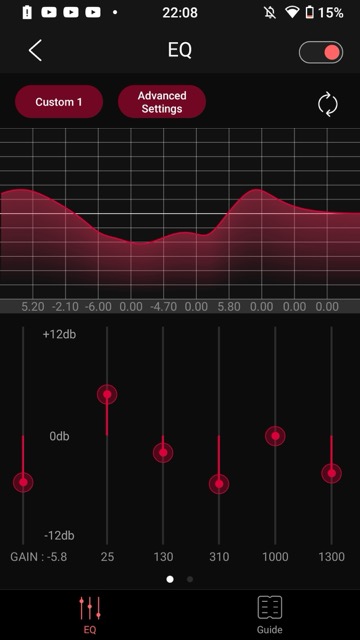
Having various profiles and especially customisable EQ/PEQ on small portable device is an incredible feature.
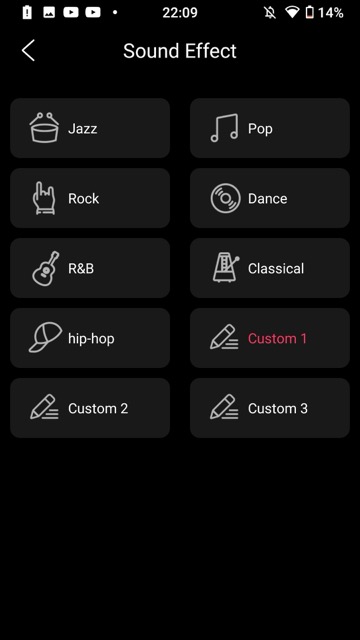
For example, Apple does not allow a system-wide EQ on IOS, and while some individual IOS music applications have some EQ capabilities, the ability to EQ your headphones for all IOS music applications is a great feature, then being able to use those same PEQ settings for your headphone when using other devices is amazing, I tested this with my Macbook Pro, my Windows 11 Laptop and also my Xiaomi Android Smartphone, and it was great to have the freedom to just have the PEQ set once for my headphones but use it everywhere and even switch profile without needing to launch an application.
While it’s excellent to have PEQ editing capabilities, I feel FiiO can do more in this area, specifically:
- Add AutoEQ support
- Import / export capabilities
- More custom Profiles (currently there are just 3 custom profiles for 3 different headphones / IEMs)
SPDIF Output
Compatibility with 3.5mm Coaxial SPDIF output allows for connections to other desktop amplifiers and DAC. This adds a unique dimension to the KA17 allowing for example your smartphone an easy yet high quality option to plug into your existing hifi stack and utilise 96kHz/24bit SPDIF audio output format.
This is the cable that is required for this feature,
and it connects into the 3.5mm headphone output, and then it must be turned within the configuration, disable the headphone
output:
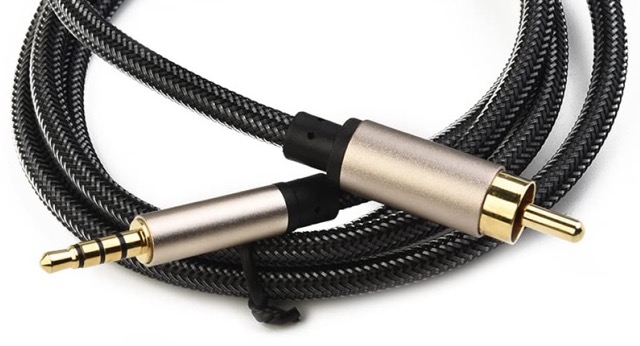
Subjective listening experience
I found the KA17 provided a very neutral response with no coloring of the audio, that is obviously when the EQ was disabled. The extra power that the KA17 provided also meant that when I needed that extra bass power I never felt lacking, I always feel you need a little headroom, and I was usually using at 70%/80% volume on my phone, I could even listen with the low gain setting and still have a little headphone with my planars.
Of course when listening to one of the built-in EQ profiles you can colour the output to your liking.
Specifications and Measurements
| Technical Specifications | |
|---|---|
| Colors | Black/Blue |
| Connectors | Type-C USB2.0 (power supply/data transfer) |
| USB Type-C POWER IN (orange, powering) | |
| DAC | ES9069Q*2 |
| USB decoding | XMOS XU316*1 |
| Supported formats | PCM: Supported up to 768kHz/32bit |
| DSD: Supported up to SD512 (Native), DOP256 | |
| SPDIF: Supported up to 96kHz/24bit | |
| Output | 3.5mm supporting 8~150Ω (Also support SPDIF) |
| 4.4mm supporting 8~300Ω | |
| Dimensions | 64mm × 27.7mm × 12.7mm |
| Display | 0.91-inch OLED display |
| Weight | 33.5g |
| SNR | 3.5mm ( Desktop mode) ≥ 123dB (A-weighted) |
| 3.5mm ( Non Desktop ) ≥ 120dB (A-weighted) | |
| 4.4mm ( Desktop mode) ≥ 126dB (A-weighted) | |
| 4.4mm ( Non Desktop ) ≥ 120dB (A-weighted) | |
| THD+N | 3.5mm ( Desktop mode) < 0.0015% 1kHz/-15dB@32Ω |
| 3.5mm ( Non Desktop ) < 0.0015% 1kHz/-10dB@32Ω | |
| 4.4mm ( Desktop mode) < 0.0004% 1kHz/-8dB@32Ω | |
| 4.4mm ( Non Desktop ) < 0.0005% 1kHz/-3.5dB@32Ω |
For those who like SINAD values a THD+N of 0.0004% = SINAD of 108db which is very impressive for a portable device
Output Power:
As you can see there are lots of different output power options depending on whether you are using the balance or single ended outputs and whether desktop mode is activated and the impedance of your headphones:
| L+R Power | PO/BAL | Desktop Mode | Ohms |
|---|---|---|---|
| 320mw + 320mw | PO | Yes | 16Ω |
| 270mw + 270mw | PO | Yes | 32Ω |
| 30mw + 30mw | PO | Yes | 300Ω |
| 110mw + 110mw | PO | No | 16Ω |
| 140mw + 140mw | PO | No | 32Ω |
| 20mw + 20mw | PO | No | 300Ω |
| 460mw + 460mw | BAL | Yes | 16Ω |
| 650mw + 650mw | BAL | Yes | 32Ω |
| 90mw + 90mw | BAL | Yes | 300Ω |
| 150mw + 150mw | BAL | No | 16Ω |
| 300mw + 300mw | BAL | No | 32Ω |
| 30mw + 30mw | BAL | No | 300Ω |
While this might seem complicated for me, it was basically that were 4 different ways of boosting the listening experience, starting with 3.5mm output, then switch to 4.4mm Balanced for a little more power, then switch on high gain if you wanted a bit more and then finally switch on desktop mode if you really wanted to maximize the output capabilities.
The real star of these power ratings is the 460mw into 16Ohms and 650mw balanced into 32Ohms with that level of power you can enjoy headphones that normally would be limited to desktop amplifiers with a small portable device and even EQ those headphones if you want.
Frequency response
FiiO have published their measurements and as you would expect from a neutral sounding dongle the FR is completely flat:
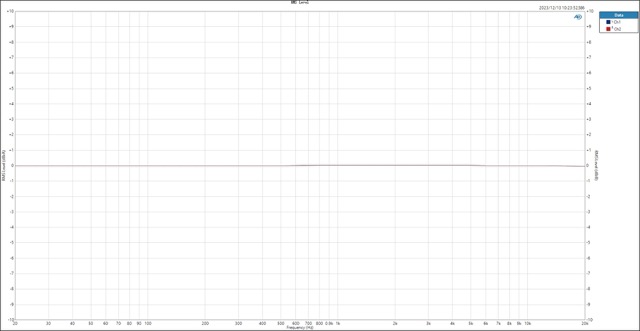
Rating
I gave the KA17 a pragmatic rating of 5 - it’s an excellent device with great features. If you want a single device that can be both a mobile DAC and a desktop DAC the KA17 is an incredible choice.
Conclusion
The Fiio KA17 represents a significant breakthrough in the USB dongle DAC market. It sounds like a desktop amplifier and has the high quality features of a desktop amplifier like a Screen, a great DAC and PEQ capabilities yet its size makes it an incredible portable device.
The KA17 sets a new standard for what to expect from a portable usb headphone dongle dac.